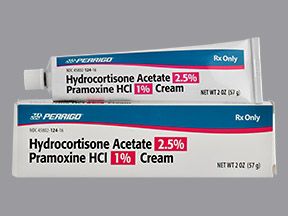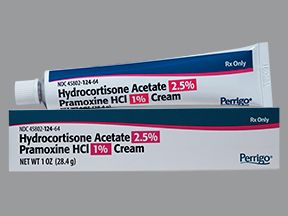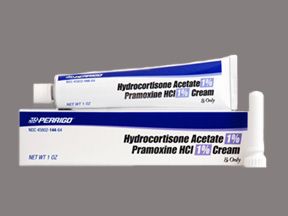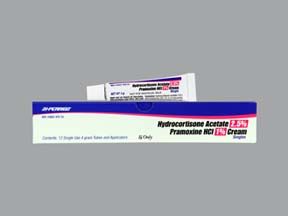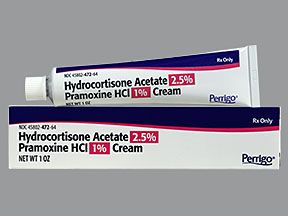Highlights for hydrocortisone-pramoxine
- Hydrocortisone-pramoxine topical cream is available as a brand-named drug and a generic drug. Brand name: Pramosone.
- Hydrocortisone-pramoxine comes in four forms: topical cream, foam, lotion, and ointment.
- Hydrocortisone-pramoxine topical cream is used to treat inflammation and itching when they occur in the anal area and when they’re related to certain skin diseases.
- Increased blood sugar level warning: Using this drug for a long time or at high doses may increase your blood sugar level. If you have diabetes, you should notify your doctor before using this drug.
- Drug effects warning: This drug can be absorbed through your skin into your body. This may affect the balance of your hormones and cause problems. This issue is more likely if you use high doses, use it for a long time, use it over a large part of your skin, or if you put dressings over the area where you apply it.
Hydrocortisone-pramoxine is a combination of the drugs hydrocortisone and pramoxine. It’s important to know about all the drugs in the combination because each drug may affect you in a different way.
Hydrocortisone-pramoxine comes in four forms: a topical cream, foam, lotion, and ointment.
Hydrocortisone-pramoxine cream is available as the brand-name drug Pramosone. It’s also available as a generic drug. Generic drugs usually cost less than the brand-name version. In some cases, they may not be available in every strength or form as the brand-name drug.
This drug may be used as part of a combination therapy. This means you may need to use it with other drugs.
Why it’s used
Hydrocortisone-pramoxine cream is used to treat inflammation and itching when they occur in the anal area and when they’re related to certain skin diseases.
How it works
Hydrocortisone belongs to a class of drugs called anti-inflammatory steroids. Pramoxine belongs to a class of drugs called anesthetics. A class of drugs is a group of medications that work in a similar way. These drugs are often used to treat similar conditions.
Hydrocortisone decreases the inflammation on your skin or anal region by blocking chemicals in the skin that cause swelling and itching. Pramoxine helps reduce itching and pain on your skin or anal region by blocking those signals in the nerves of your skin.
Hydrocortisone-pramoxine doesn’t cause drowsiness, but it can cause other side effects.
More common side effects
The adult side effects for this drug are slightly different from the side effects for children.
More common side effects in adults include:
- burning
- itching
- irritation
- dryness
- hair growth
- acne
- skin discoloration
- infection
- stretch marks
In addition to the side effects listed above, children may experience:
- slowed growth
- slowed weight gain
- lowered cortisol levels
If these effects are mild, they may go away within a few days or a couple of weeks. If they’re more severe or don’t go away, talk to your doctor or pharmacist.
Disclaimer: Our goal is to provide you with the most relevant and current information. However, because drugs affect each person differently, we cannot guarantee that this information includes all possible side effects. This information is not a substitute for medical advice. Always discuss possible side effects with a healthcare provider who knows your medical history.
An interaction is when a substance changes the way a drug works. This can be harmful or prevent the drug from working well.
To help avoid interactions, your doctor should manage all of your medications carefully. Be sure to tell your doctor about all medications, vitamins, or herbs you’re taking. To find out how hydrocortisone-pramoxine cream might interact with something else you’re taking, talk to your doctor or pharmacist.
Disclaimer: Our goal is to provide you with the most relevant and current information. However, because drugs interact differently in each person, we cannot guarantee that this information includes all possible interactions. This information is not a substitute for medical advice. Always speak with your healthcare provider about possible interactions with all prescription drugs, vitamins, herbs and supplements, and over-the-counter drugs that you are taking.
Children and hydrocortisone
- Children may be more sensitive to hydrocortisone. This drug may have very minor effects on their growth. Children who are treated with this drug should use the least amount possible that provides improvement in their skin condition.
This drug comes with several warnings.
Allergy warning
Hydrocortisone-pramoxine can cause a severe allergic reaction. Symptoms can include:
- trouble breathing
- swelling of your throat or tongue
If you develop these symptoms, call 911 or go to the nearest emergency room.
Don’t use this drug again if you’ve ever had an allergic reaction to it. Using it again could be fatal (cause death).
Contact with drug warning
This drug can be transferred to other people. If other people touch the skin where you apply this drug, it may be absorbed through their skin. Talk to your doctor about how you can prevent this from happening.
Warning for people with diabetes
If you use this drug for a long time or use it in high doses, it may increase your blood sugar level. Talk to your doctor before using this drug. You may need to monitor your blood sugar level more carefully.
Warnings for other groups
For pregnant women: This drug is a category C pregnancy drug. That means two things:
- Research in animals has shown adverse effects to the fetus when the mother uses the drug.
- There haven’t been enough studies done in humans to be certain how the drug might affect the fetus.
Talk to your doctor if you’re pregnant or planning to become pregnant. This drug should only be used if the potential benefit justifies the potential risk.
If you become pregnant while using this drug, call your doctor right away.
For women who are breastfeeding: It is not known whether this drug passes into breast milk. Talk to your doctor if you breastfeed your child.
For children: Children may be more sensitive to the effects of hydrocortisone. Hydrocortisone may have very minor effects on their growth. Children who are treated with this drug should be prescribed the smallest dose that’s effective for their condition.
All possible dosages and drug forms may not be included here. Your dosage, drug form, and how often you use the drug will depend on:
- your age
- the condition being treated
- how severe your condition is
- other medical conditions you have
- how you react to the first dose
Dosage for inflammation and itching
Generic: Hydrocortisone-pramoxine
- Form: topical cream
- Strengths: 1% or 2.5% hydrocortisone and 1% pramoxine
Brand: Pramosone
- Form: topical cream
- Strengths: 1% or 2.5% hydrocortisone and 1% pramoxine
Adult dosage (ages 18 years and older)
Apply a thin film of the drug to the affected skin three to four times per day.
Child dosage (ages 0–17 years)
- There are no specific dosing recommendations for the use of this drug in people younger than 18 years.
- This drug should be used with caution in people younger than 18 years. They are at increased risk of side effects.
Disclaimer: Our goal is to provide you with the most relevant and current information. However, because drugs affect each person differently, we cannot guarantee that this list includes all possible dosages. This information is not a substitute for medical advice. Always speak with your doctor or pharmacist about dosages that are right for you.
Hydrocortisone-pramoxine cream is used for short-term treatment. It comes with risks if you don’t use it as prescribed.
If you stop using the drug suddenly or don’t use it at all: Your symptoms of itching or dryness may get worse.
If you miss doses or don’t use the drug on schedule: Your medication may not work as well.
How to tell if the drug is working: You should notice decreased burning, itching, or dryness.
Keep these considerations in mind if your doctor prescribes hydrocortisone-pramoxine for you.
Storage
- Store this cream at 77°F (25°C). You can store it for short periods between 59°F and 86°F (15°C and 30°C).
- Don’t store this medication in moist or damp areas, such as bathrooms.
Refills
A prescription for this medication is refillable. You should not need a new prescription for this medication to be refilled. Your doctor will write the number of refills authorized on your prescription.
Travel
Always carry your medication with you when you travel:
- When flying, never put it into a checked bag. Keep it in your carry-on bag.
- Don’t worry about airport X-ray machines. They can’t harm your medication.
- You may need to show airport staff the pharmacy label for your medication. Always carry the original prescription-labeled container with you.
- Don’t put this medication in your car’s glove compartment or leave it in the car. Be sure to avoid doing this when the weather is very hot or very cold.
Self-management
Your doctor may have you cover the area where you apply this drug with gauze or another dressing. Only do this if your doctor tells you to do so. If they don’t, avoid bandaging, covering, or wrapping the treated skin.
Availability
Not every pharmacy stocks this drug. When filling your prescription, be sure to call ahead to make sure your pharmacy carries it.
Hidden costs
If your doctor tells you to dress the affected areas of your skin, you may need to purchase:
- gauze
- medical tape
Prior authorization
Many insurance companies require a prior authorization for this drug. This means your doctor will need to get approval from your insurance company before your insurance company will pay for the prescription.
There are other drugs available to treat your condition. Some may be better suited for you than others. Talk to your doctor about other drug options that may work for you.
Disclaimer: Healthline has made every effort to make certain that all information is factually correct, comprehensive, and up-to-date. However, this article should not be used as a substitute for the knowledge and expertise of a licensed healthcare professional. You should always consult your doctor or other healthcare professional before taking any medication. The drug information contained herein is subject to change and is not intended to cover all possible uses, directions, precautions, warnings, drug interactions, allergic reactions, or adverse effects. The absence of warnings or other information for a given drug does not indicate that the drug or drug combination is safe, effective, or appropriate for all patients or all specific uses.

